
|
| (Image: Hydraulic bursting head (Xpandit) in contracted positions [Sterl01]) | | (Image: Hydraulic bursting head (Xpandit) in expanded positions) |
In the hydraulic expansion system, the bursting process advances from the insertion pit to the reception (pulling) pit in sequences, which are repeated until the full length of the existing pipe is replaced. In each sequence, one segment of the pipe (which matches the length of the bursting head) is burst … |

|
In the static pull system, the force for breaking of the existing pipe comes only from pulling the bursting head forward. The head is pulled by either a pulling rod assembly (TRS system) or a winch cable, which is inserted through the existing pipe and attached to the front of the bursting head. The tensile force applied to the bursting head is significant. The cone-shaped bursting head transfers this horizontal pulling force into a radial force, … |

|
(Image: Pneumatic, hydraulic and static head [Sterl01]) Currently available pipe bursting systems can be classified into three main classes: (1) pneumatic pipe
bursting, (2) hydraulic expansion, and (3) static pull, which is based on the type of bursting head used.
Pneumatic head uses pulsating air pressure to drive the head forward and burst the old pipe. A small
pulling device guides the head via a constant tension winch and cable. Hydraulic head … |

|
(Image: The crushing head in implosion (IMPIPE System) [Sterl01]) In the "implosion" system, the bursting tool consists of two parts: a crushing head, which breaks the existing pipe and forces the pipe fragments inwards into the pipe void, and a steel cone, which pushes the crushed pipe fragments and soil outwards, making room for the new pipe. The crushing head is cylinder-shaped, and slightly larger than the existing pipe. Inside the cylinder, there … |

|
|
(Image: Pipe splitting system [Sterl01])
|
|
(Image: Section view of the pipe splitting system (ConSplit) [Sterl01])
|
Pipe splitting system is used for pipes that are not brittle, like steel and ductile iron gas mains. Instead of the bursting head, the system uses a splitter, which cuts the existing pipe along one line on the bottom and opens it out, rather than fracturing it. The splitter is pulled through the existing pipe by either a wire rope … |

|
Pipe eating is a modified microtunneling system specially adapted for pipe replacement. The existing defective pipeline is crushed and removed through the new pipeline by the circulating slurry system. A new pipe is simultaneously installed by jacking it behind the microtunneling machine. The new pipe may follow the line of the old pipe on the entire length, or may cross the elevation of the old pipe on a limited segment only. The system is remotely … |

|
(Image: Pipe reaming [Sterl01]) Pipe reaming is a modified back reaming method used in directional drilling, which is specially adapted for pipe replacement. First, the pilot drill string is inserted through the existing pipe. Next, a specially designed reaming tool is attached to the drill string and pulled back through the pipe, while simultaneously installing the new pipe. The reamer has cutting teeth, which grind and pulverize the existing pipe … |

|
Pipe ejection (modified pipe jacking) and pipe extraction (modified static pull) are pipe replacement systems, in which the unbroken existing pipe is removed from the ground, while the new pipe is simultaneously installed. The old pipe is broken into pieces only as it completely exits out of the ground. These techniques are applicable only for pipes with sufficient remaining thrust capacity to withstand the push or pull forces. They are used on shorter … |

|
CLG (Controlled Line and Grade) System is a pipe replacement method with ability to correct sags, humps or misalignments in existing pipelines. The system is new on the trenchless market, with patent still pending and limited field experience. A steel rod string that consists of short steel rods coupled together is inserted through the existing pipe, along its entire length. After the rod string is precisely aligned to the desired line and grade … |

|
|
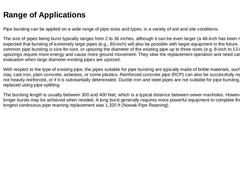
|
Pipe bursting can be applied on a wide range of pipe sizes and types, in a variety of soil and site conditions. The size of pipes being burst typically ranges from 2 to 36 inches, although it can be even larger (a 48-inch has been replaced). It is expected that bursting of extremely large pipes (e.g., 80-inch) will also be possible with larger equipment in the future. The most common pipe bursting is size-for-size, or upsizing the diameter of the … |
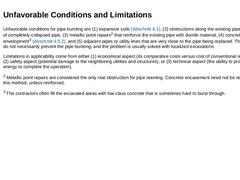
|
Unfavorable conditions for pipe bursting are (1) expansive soils (Abschnitt 6.1), (2) obstructions along the existing pipe length in form of completely collapsed pipe, (3) metallic point repairs2 that reinforce the existing pipe with ductile material, (4) concrete envelopment3 (Abschnitt 4.5.2), and (5) adjacent pipes or utility lines that are very close to the pipe being replaced. The obstructions do not necessarily prevent the pipe bursting, and … |

|
|
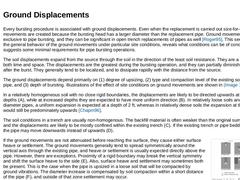
|
Every bursting procedure is associated with ground displacements. Even when the replacement is carried out size-for-size, soil movements are created because the bursting head has a larger diameter than the replacement pipe. Ground movements are not exclusive to pipe bursting, and they can be significant in open trench replacements of pipes as well [Roger95]. This section explains the general behavior of the ground movements under particular site … |
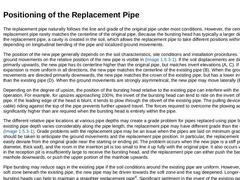
|
The replacement pipe naturally follows the line and grade of the original pipe under most conditions. However, the centerline of the replacement pipe rarely matches the centerline of the original pipe. Because the bursting head has typically a larger diameter than the replacement pipe, a cavity is created in the soil, which allows the replacement pipe to take different positions within the cavity, depending on longitudinal bending of the pipe and … |
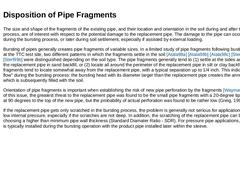
|
The size and shape of the fragments of the existing pipe, and their location and orientation in the soil during and after the bursting process, are of interest with respect to the potential damage to the replacement pipe. The damage to the pipe can occur either during the bursting process, or later during soil settlement, especially if assisted by external loading. Bursting of pipes generally creates pipe fragments of variable sizes. In a limited … |
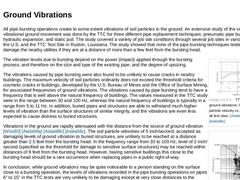
|
All pipe bursting operations create to some extent vibrations of soil particles in the ground. An extensive study of the velocity of vibrational ground movement was done by the TTC for three different pipe replacement techniques: pneumatic pipe bursting, hydraulic expansion, and static pull. The study covered a variety of job site conditions through several job sites in various regions of the U.S. and the TTC Test Site in Ruston, Louisiana. The study … |
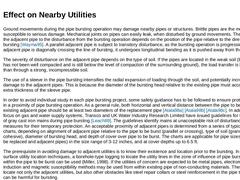
|
Ground movements during the pipe bursting operation may damage nearby pipes or structures. Brittle pipes are the most susceptible to serious damage. Mechanical joints on pipes can easily leak, when disturbed by ground movements. The response of the adjacent pipe to the disturbance from the bursting operation depends on the position of the pipe relative to the direction of bursting [Wayma95]. A parallel adjacent pipe is subject to transitory disturbance, … |
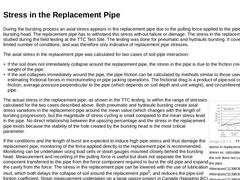
|
During the bursting process an axial stress appears in the replacement pipe due to the pulling force applied to the pipe behind the bursting head. The replacement pipe has to withstand this stress without failure or damage. The stress in the replacement pipe was studied during the field testing at the TTC Test Site. The testing was done for pneumatic and hydraulic bursting. It covered only a limited number of conditions, and was therefore only indicative … |

|
|
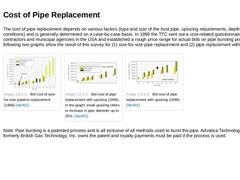
|
The cost of pipe replacement depends on various factors (type and size of the host pipe, upsizing requirements, depth, ground conditions) and is generally determined on a case-by-case basis. In 1999 the TTC sent out a cost-related questionnaire to contractors and municipal agencies in the USA and established a rough price range for actual bids on pipe bursting projects. The following two graphs show the result of this survey for (1) size-for-size … |
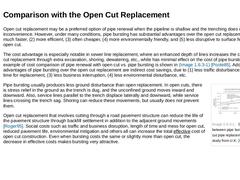
|
Open cut replacement may be a preferred option of pipe renewal when the pipeline is shallow and the trenching does not create inconvenience. However, under many conditions, pipe bursting has substantial advantages over the open cut replacements. It is (1) much faster, (2) more efficient, (3) often cheaper, (4) more environmentally friendly, and (5) less disruptive to surface features than open cut. The cost advantage is especially notable in sewer … |
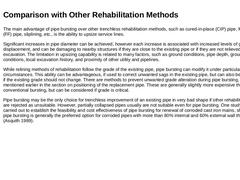
|
The main advantage of pipe bursting over other trenchless rehabilitation methods, such as cured-in-place (CIP) pipe, fold-and-form (FF) pipe, sliplining, etc., is the ability to upsize service lines. Significant increases in pipe diameter can be achieved, however each increase is associated with increased levels of ground displacement, and can be damaging to nearby structures if they are close to the existing pipe or if they are not relieved by local … |
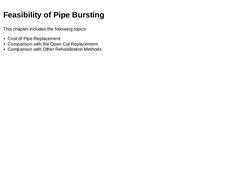
|
|

|
Pipe bursting is extensively used to renew aged pipelines in the USA and worldwide, and the use of this method is increasing. A total footage of pipe replacement per year was, in the USA, approximately 16,000 ft or less in 1994, and about 500,000-ft in 1997. The market is favorable, and the total footage is growing at approximately 20% per year (Hopwood, 1998). Pipe bursting is currently more popular in the sanitary sewer market in the USA, than in … |